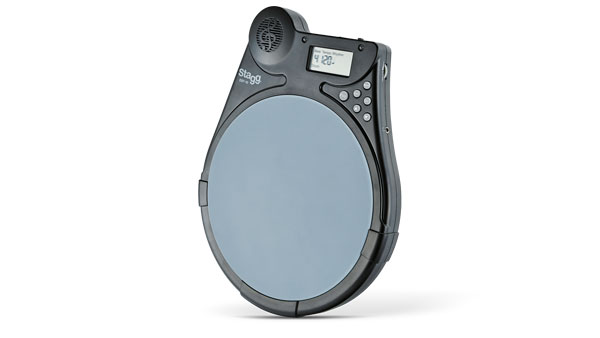MusicRadar Verdict
The EBT-10 is good for a pre-gig warm up and comes with some useable practice routines. However, lacking dynamics and no sound from most stick strikes, the EBT-10 loses brownie points.
Pros
- +
Good selection of grooves. Sensible design. Stroke Meter is useful.
Cons
- -
No velocity measure. Most functions lack snare sound.
MusicRadar's got your back
Stagg boasts a wide and varied product range of affordable musical instruments including guitars, drums, cymbals, percussion and accessories. Priced at well under £50, this practice pad upholds Stagg's budget principles - but what features can we expect for this meagre sum?
The onboard training exercises are said to help develop speed, endurance, finesse, relaxation and control - so we are looking forward to seeing how this is achieved.
Build
This compact unit features a "natural rebound" 7.5" silicon pad set in an ABS frame. Though the EBT-10 will run from the mains (with an optional adaptor), it is also battery powered by single 9-volt PP3 battery. Weighing only 800g and being no larger than a standard practice pad, this is a highly-portable, play anywhere practice tool.
"The grooves are well-constructed, guiding you through ZZ-Top style rhythms to others that James Brown would be happy with"
It is designed to be played on any flat surface such as a table or is mountable on a stand via the nut located on the underside of the pad. When placed on a hard surface, impact-absorbing EVA cushioning helps avoid any nasty impacts on the wrists. Located towards the top of the EBT, out of harm's way of any stray stick strikes, are all the control buttons.
Sited just off-centre and to the right of the output speaker is a back-lit LCD display - when this dims or doesn't illuminate, it is a sign the battery needs replacing. Two LEDs take turns to illuminate with red for the downbeat and green for each subsequent beat, while the metronome produces either a beep or a drum groove depending on user preference.
Sound output is via a tiny integral piezo-type speaker but if quieter practice is required, output is also available through headphones via a 2.5mm jack or, of course, the volume can simply be turned down. The combination of two LEDs and/or sound from the metronome helps guide the user through each bar.
Hands On
As the EBT-10 is switched on, the LCD screen momentarily displays each of the possible functions - only a second later the practice pad becomes instantly available, defaulting swiftly into metronome mode.
Want all the hottest music and gear news, reviews, deals, features and more, direct to your inbox? Sign up here.
Pressing play (which works as a stop/start), the EBT defaults to 'Metronome Mode' displaying Beat (time signature) 4/4, Tempo 120bpm and Rhythm (phrasing intervals) initially set to quarter notes.
To move to the next signature or tempo, the metronome has to be stopped and using the Sel. (select), and either of the up and down buttons, alters the parameters. As mentioned above, Stagg says the pad will help develop (amongst the other aspects), finesse, but as the unit is not velocity sensitive, this is not possible to measure. We also quickly learn that unless you are in Tap Function, there is no actual snare sound - little feedback and no dynamics.
However, the decent selection of grooves are well-constructed, guiding you through ZZ-Top style rhythms to others that James Brown would be happy to hurtle around the stage with. 'Count and Mute' is an excellent routine for instilling time - a vitally important attribute for any player.
One of the training functions which should help develop speed is 'Stroke Meter' - this is great fun to see how fast you can hit, in anything between 10 and 90 seconds.
